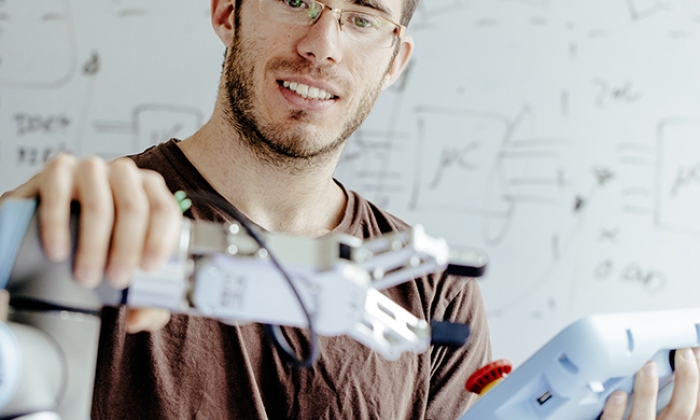7 reasons why you should invest in a collaborative robot


What is a Cobot?
A contraction of the words “collaborative” and “robot”, a cobot is a robot specifically designed to work together with humans, which is in stark contrast to the traditional stationary industrial robots that work separately and in isolation from human contact.
They are equipped with sensors and force and power limiting safety features that make collaboration between robot and human possible. This type of collaboration makes the production process shorter, increases productivity, reduces the defect rate and supports the employees in their work making them more efficient and valuable instead of replacing them.
In the manufacturing industry, productivity is the key to success. And the more productivity can be increased, the more profitable the business becomes. In recent years, more and more have chosen to implement cobots or collaborative robots, as the term covers.
Here are the 7 reasons why you should consider investing in a cobot yourself:
1. Cobots are easy to program
Many newer cobot models are designed to be user friendly and easy to program, eliminating the need for an engineer to implement it. Some even have hand guiding features where the cobot literally learns by example while being guided through the sequence of movements needed to do the task it is being programed for.
2. Can be set up in short time
The longer it takes to set up automation the more expensive the initial investment gets. High costs of staff training, production stops and having to hire external service providers can quickly increase the time it takes to see the return on investment. These issues can prove to be highly problematic for small and medium-sized companies.
Collaborative robots are designed with short deployment time in mind and come with out-of-the-box functionality. The latest models can be set up in less than 30 minutes due to pre-programing software that enables the user to install the robot themselves. Furthermore, the flexibility that comes with the short redeployment of the cobot increases productivity and ROI.
3. Cobots can be used for different applications
One of the main selling points for cobots is their flexibility. Programming a cobot for a new task is simple and an external service worker is not necessary. This introduces a versatility into the production line and the cobot can easily be set up doing a sequence of different tasks in the same day or have designated days for certain tasks.
Cobots can easily be integrated into agile systems since they allow the staff to quickly respond to design changes and redeploy the cobot accordingly.
The cobots currently on the market can fill many roles that are usually divided into service and industrial. Service cobots are used for providing information in public spaces, transporting goods or providing security. Industrial cobots have several applications including but not limited to pick and place, packaging and palletizing, assembly, machine tending, surface finishing and quality testing and inspection.
4. A cobot is more consistent and accurate than a human
Robots never tire, making them more consistent and accurate workers than their human counterparts. This makes them especially suitable for monotonous tasks, as they can perform simple action repeatedly without their work quality diminishing. Cobots perform the same task with the same power as long as you need them to.
5. Positive impact on the employees
The common worry of workers in manufacturing is that they will be replaced by machines that are faster, more precise and never tire. Truth is that this scenario is highly unlikely. Especially within companies with high mix and low volume production as traditional industrial machines commonly in use have high costs and low flexibility.
This opens the door to what is now being called the fourth industrial revolution.
Information technology is used for smart manufacturing, placing the human workforce and collaborative robots side by side, with no need to reduce the size of the staff. The workers are not replaced by machines. Instead, by using cobots, the worker is spared of repetitive processes and his time is freed so it can be used for more complex processes thus improving the day-to-day experience of the workers.
Cobots support the human staff, taking over tasks that are dangerous, dirty and dull creating a safer and more enjoyable workspace.
6. Cobots increase productivity and optimize processes
The cobot takes over processes where a human worker would have trouble keeping focus or keep the performance at a consistent level over a long period of time. Here we talk about monotonous tasks or tasks that require the worker to hold an unergonomic position.Their precision reduces failure and product defect possibility to almost zero.
Changing the tasks the cobot is intended to perform is fast, which helps the workers optimize the production line and cut costs, while keeping the high standards of product quality.
7. Fast payback period
Cobots cost less than industrial robots and depending on which application it is used for and for how long, can potentially earn back the investment in as few as 200-300 days.

|
Jak rozwijać firmę za pomocą aplikacji współpracujących
Dzięki inteligentniejszym narzędziom o większych możliwościach dostosowania, roboty mogą obecnie pracować przy większej prędkości, sile i dokładności oraz zwiększonemu bezpieczeństwu, wykonując szeroki zakres zadań przy jednoczesnym maksymalizowaniu zwrotu z inwestycji. Pobierz nasz bezpłatny e-book i sprawdź, jak umożliwić szybszą produkcję przy niższych kosztach.
POBIERZ BEZPŁATNY eBOOK
|

|

